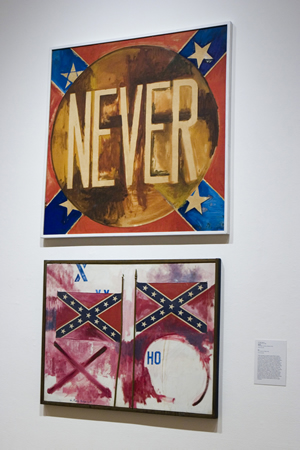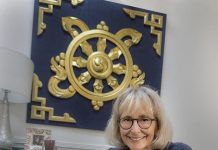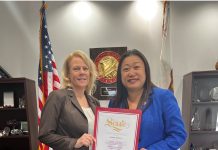Laguna Beach artist G. Ray Kerciu believes political correctness motivated South Carolina’s governor to call for the removal of the Confederate flag from the state’s capitol. The decades-old debate over a flag symbolic of racism reignited following a racially motivated shooting of nine African-Americans last month.

The debate also prodded Kerciu to dust off his own social protest relics from 50 years ago, paintings of the Confederate flag that he offered as last minute additions to a Laguna Art Museum exhibit.
“We thought it was that important and timely,” said Kerciu, who described to visitors at the exhibit opening last Saturday what provoked him to use the Confederate battlefield flag to mock one of the earliest flashpoints in the civil rights movement.
“I’m quite proud of them still,” said the artist, who used symbolism that provided a narrative and distilled his anger on canvas at his second teaching appointment at the University of Mississippi. The young professor was on campus in 1961 when the arrival of the first African American student was met with bigotry and rioting between Federal marshals and segregationists. “It was the Confederacy rising again,” Kerciu recalled in an interview this week.
One of the paintings in the Laguna exhibits depicts a black and white button with the word “Never” centered over the flag’s twin bars of crossed stars. Ole Miss students wore similar lapel buttons to show their intransigence to integration, said Kerciu. The work, exhibited in the university art center, landed Kercui in jail in Oxford, Miss., arrested for desecration of the Confederate flag and obscenity.
Today in Southern California, the flags received a more muted response. No

museum visitors have signaled their feedback negative or positive about the paintings, said development director Ed Fosmire.
In their day, the series – which included paintings with racially charged graffiti — built Kerciu’s “reputation as someone who helped focus the emotional angst of the campus protesters,” said Gene Cooper, a Cal State Long Beach professor of art history wrote in an unpublished essay.
Kerciu’s arrest was reported in Time magazine and his work elicited praise from luminaries such as Malcolm X and John Steinbeck, Kerciu remembered. When he left Mississippi for New York, his paintings received a showing in the high-profile Martha Jackson Gallery that exhibited groundbreaking pop artists like Andy Warhol, Robert Rauschenberg and Jasper John, who Kerciu said stopped in to see his work.
Though he worked in the pop style popularized by Warhol and others, “no one was doing socially conscious work,” said Kerciu. He enjoyed his “15 minutes of fame” and decamped for California in 1963.
Among the founding faculty of Cal State Fullerton’s art department, Kerciu founded the printmaking department and was instrumental in founding the university’s Grand Central Art Center in Santa Ana. He retired in 2002 after 39 years on campus.
A Michigan native, Kercui initially settled in Long Beach. After a sabbatical trip where he studied on the French Riviera, Kerciu relocated to Laguna Beach, which felt to him like the Mediterranean coast he had just left.
And despite leaving the south, Kerciu never lost his bent for social activism. It took a new path outside the studio in the ‘90s. He played a prominent role in organizing opponents who eventually defeated the proposed merger by the Laguna Art Museum with the Newport Harbor Museum. He went on to become president of the Laguna museum board. “I’m very proud it’s here to stay,” he said.
Two years ago, Fullerton’s on-campus Begovich Gallery assembled “Radical Retrospective,” a survey of 59 of Kerciu’s works, which also included examples from the Confederate series that tackled inequality and racism.
After the Charleston massacre revived debate about the Confederate flag, Kerciu called the museum’s Executive Director Malcolm Warner last week to urge him to add his paintings to the new exhibit. “These things need to be dusted off. It’s been 50 years, but how important they still are,” said Kerciu, gratified his work remains relevant social commentary.
In retirement, the artist has reinvented himself and now focuses on architectural wooden tower sculptures. His work is in the collections of the Laguna Art Museum and the Norton Simon Museum in Pasadena.
He will discuss his work and its controversial rise to prominence at a 6 p.m. talk Thursday, July 23.





Excellent statement Then, and NOW!
I would like to remind the readers that most of the defenders of the Battle Flag of Northern Virginia think of it as defending Northern Aggression against the right to own SLAVES! That’s the meaning of STATE’S RIGHTS! Ask Saint Ronnie or all the other 10thers!
[…] the former executive director of Laguna Playhouse, beat out Laguna Beach arts activist G.Ray Kerciu by a single […]
[…] who hate tend to love each other,” he said. The flag paintings were exhibited in 2015 at the Laguna Art Museum, where one is on […]